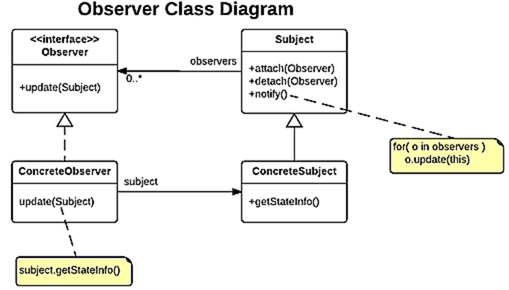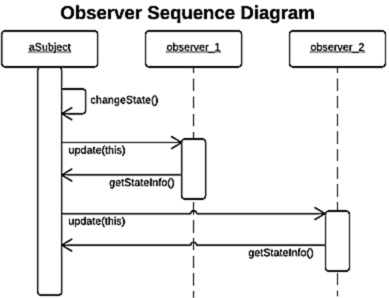Week 2 Glossary
This "glossary" is arranged chronologically - in the order the material is presented in class - rather
than alphabetically. The following Table of Contents links to the items alphabetically.
Table of Contents
- Class responsibilities
- Cohesion
- Coupling
- DRY
- Design pattern
- Java Observable / Observer
- Observer pattern
- Refactoring
- Separation of Concerns
- Technical debt
Terms, Definitions, and Examples
DRY (Don't Repeat Yourself)
The Pragmatic Programmer. Andrew Hunt & David Thomas. Addison-Wesley, 1999.
One to consider for your own Programming on a Remote Island book list.
Every piece of information (data, algorithm, code sequence) should have a single, definitive location in the code base. Duplication wastes effort, leads to bugs
when all copies of code are not found and updated at the same time. Redundancy
always risks inconsistency.
Cohesion
Wikipedia
The degree to which a component addresses a single, well-defined issue;
cohesion measures the strength of relationship between pieces of
functionality within a given module.
A primary design goal is to create highly cohesive components.
Component
is purposefully vague - depending on the level of abstraction it can be a method, a class, or a collection (subsystem) of classes.
A cohesive method solves one problem in the context of the class in which it
resides. A cohesive class represents a coherent abstract entity in the application.
A cohesive subsystem addresses one of the application's key issues (e.g., the
printing subsystem).
SOC (Separation Of Concerns)
Wikipedia
A concrete principle supporting cohesion. A component - in our case, typically a
class - should address a single aspect of the overall problem. An example of SOC
failure is a weather station that controls and samples sensors AND directly
controls the display of the samples it takes.
Class Responsibilities
What a class (or more likely its objects) knows and what it can do.
Know in this sense is the state it manages - its instance variables, including
those that refer to other application classes. Do means actions it can take
in response to method invocations. What a class knows should be exactly what is
required for what the class objects can do; avoid irrelevant information.
A class that knows nothing is pure computation. While this is sometimes appropriate,
usually it is an indication that the behavior belongs in another class that contains
the information needed to do the work.
A class that does nothing is pure data. These arise from time to time, but one
should always ask whether the data belongs in another class - perhaps "broken off"
from a class that does a lot and knows little.
Classes, of course, can have too many responsibilities, which is usually an indicator
of low cohesion and violation of SOC.
Coupling
Wikipedia
Coupling is the manner and degree of interdependence between software modules.
In general, the less the interdependence - the lower the coupling - the better.
A crude but useful measure of coupling is the number of other components a given
component references; in a UML class diagram, this can be estimated by the
number of lines going into and out of a given class.
More significant is the manner of the connection. Simply calling a method in
a "logging" class to record an event is low coupling; depending on a variety
of methods that must be used in a specific sequence is high coupling.
Technical Debt
Wikipedia
A term coined by Ward Cunningham in the 1992. From Cunningham's paper:
Shipping [...] code is like going into debt. A little debt speeds
development so long as it is paid back promptly with a rewrite...
The danger occurs when the debt is not repaid. Every minute spent on
not-quite-right code counts as interest on that debt. Entire engineering
organizations can be brought to a stand-still under the debt load of an
unconsolidated implementation, object-oriented or otherwise.
Technical debt can be thought of as work that needs to be done before a particular job can be considered complete or proper. If the debt is not repaid, then it will keep on accumulating interest, making it hard to implement changes later on.
Technical debt is not necessarily bad as long as you realize it is accumlating.
Carrying a bit of debt that is promptly paid off (consider a house mortgage or
student loan). But piling on debt thoughtlessly (as with credit cards) can lead
to debt that can never be paid off. In the finance world this means bankruptcy;
in software this means scrapping a useful program and starting all over.
Examples of technical debt include (but are not limited to):
Code that is poorly structured, uses arcane names, has inconsistent indentation,
and is devoid of useful comments.
Code changes made without updating associated requirements and design documentation.
Quick patches to repair serious operational problems.
Short-cuts taken to make a hard release date.
In summary, consider this quote from Grady Booch
So it is [...] in
software-intensive systems. Users suffer the consequences of capricious
complexity, delayed improvements, and insufficient incremental change; the
developers who evolve such systems suffer the slings and arrows of never
being able to write quality code because they are always trying to catch up.
Refactoring
Refactoring: Improving the Design of Existing Code. Martin Fowler (Addison-Wesley, 1999).
One to consider for your own Programming on a Remote Island book list.
Refactoring is restructuring existing computer code
without changing its external behavior.
Refactoring aims to improve nonfunctional attributes such as readability, maintainability, and design integrity. As such, refactoring is one technique
to help keep technical debt under control.
In mature software organizations, refactoring is not a separate development
phase. Instead, the programmers and engineers constantly improve the product
by performing "micro-refactorings" in parallel with enhancing the product's
function. It has been said that a good development team will proceed by
"designing a little, programming a little, refactoring a little."
While refactoring is integrated into the normal workflow, it is a distinct
activity. At any given time a developer may be refactoring or adding
functionality, but not both. The reason is that refactoring should not
change the behavior, and the only way to assure this is to keep the behavior
the same. Once refactoring is complete and validated, then development can
proceed (from a somewhat better code base).
Design Pattern
Design Patterns: Elements of Reusable Object-Oriented Software. E. Gamma,
et.al. (Addison-Wesley, 1994).
One to consider for your own Programming on a Remote Island book list.
A design pattern is the re-usable form of a solution to a design problem.
Software design patterns derive from the work on (building) architectural patterns
by architect Christopher Alexander. What Alexander said about architectural patterns
applies as well to software design patterns:
Each pattern describes a problem that occurs over and over again in our
environment, and then describes the core of the solution to that problem,
in such a way that you can use this solution a million times over, without
ever doing it the same way twice.
The Timeless Way of Building, Oxford University Press(1979).
A software design pattern addresses a problem in a way that balances the
application of design principles to enhance reuse and maintainability.
Observer Pattern
Wikipedia
Define a one-to-many dependency between objects so that when
the one object changes state, all its dependents are notified and
updated automatically. You don't want to maintain the consistency
by tightly coupling the classes because that reduces reusability.


The object whose state is monitored is called the subject; those objects
interested in state changes are called observers. In the canonical approach
given in the Gang of Four, the subject comprises:
- An abstract superclass Subject
which is responsible for attaching and detaching Observer objects, and for
invoking the update method of all attached observers when its notify is called.
- An extending class ConcreteSubject, which contains the changeable state
being observed. ConcreteSubject objects use the superclass notify method
to broadcast state changes to the observers.
The superclass Subject and the subclass ConcreteSubject
illustrate Separation of Concerns within a single object via
inheritance:
- The abstract Subject superclass does generic management of dependent Observers
- The ConcreteSubject does the real work, with periodic notifications.
The Observer interface simply defines the update method to be called
when any observed Subject changes. The Observer then interrogates
the changed information and does whatever is appropriate. Things get a tad more
complicated if an Observer is observing multiple Subjects, because the
Observer must determine which Subject called update.
Java Observable / Observer
Observer
Observable
The Java libraries support a version of the Observer pattern via the
Observable class and the Observer interface
in the java.util package:
-
Observable is Java's version of Subject from the design pattern.
Methods addObserver and deleteObserver are used for attaching and detaching,
respectively, and state changes are broadcast by calling notifyObservers.
However, broadcast only occurs when setchanged has been called (and not cleared)
since the last notification. You should consider why this might be useful.
A variant of notifyObservers has a Java Object argument that is passed as part of each observer's update call (this can be used to pass along
arbitrary change information).
Finally, there are a variety of convenience methods
in Observable.
-
Observer defines the
update(Observable o, Object arg)
method. The first argument is the Observable that called update (making it
easier to observe many objects). The second argument is an Object holding
any information related to the update. As noted above, providing such an object
is optional on the Observable's part, and in such a case will
be null.

